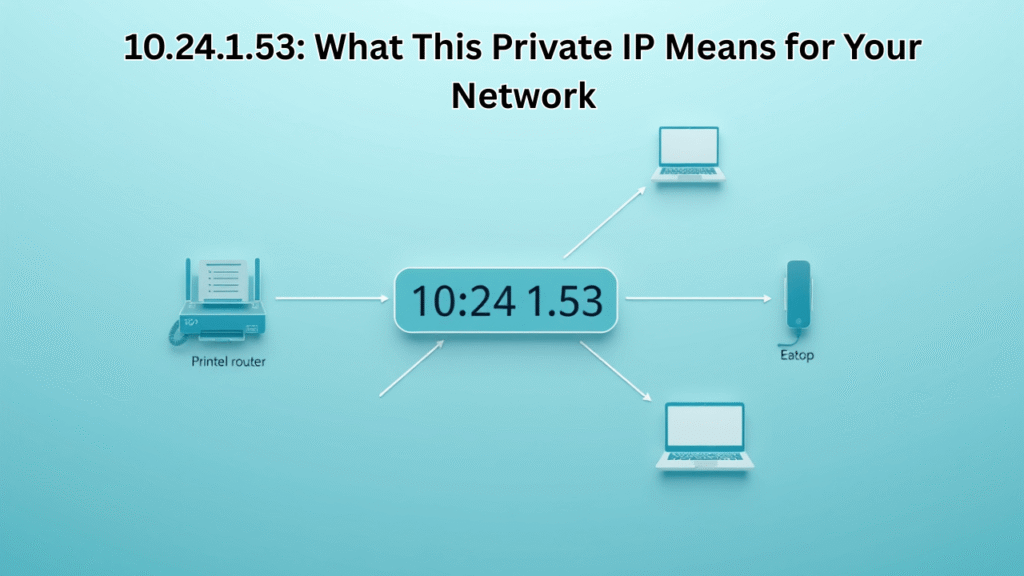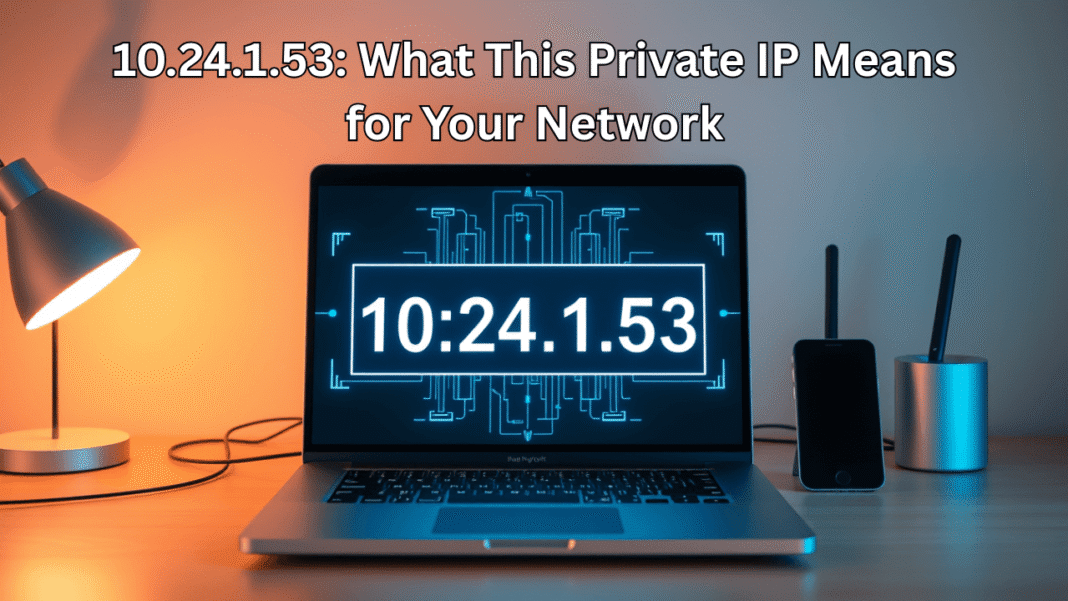Let’s talk about something that’s quietly working behind the scenes of your digital life—10.24.1.53. Not exactly a household name, but if your Wi-Fi’s running, your printer’s cooperating, or your office network feels smooth as silk, this IP address might just be doing its job—without needing applause.
This isn’t some mysterious code. It’s not a location tracker or a hacker’s disguise. It’s just a private IP. A humble one. But it’s also part of the reason your devices talk to each other like old friends.
Let’s break it down and get into the nuts and bolts of why 10.24.1.53 matters more than you think.
What Exactly Is 10.24.1.53?

Picture your home network as a little digital city. Each device—your laptop, your phone, even your smart fridge—needs an address to function. That’s where 10.24.1.53 comes in.
This address belongs to a range of private IPv4 addresses: specifically from 10.0.0.0 to 10.255.255.255. These addresses don’t exist on the public internet. Instead, they’re local. They’re reserved. Think of them like the backstage passes of your network—they get you where you need to go, but you won’t see them in the spotlight.
Your router probably assigned it. It connects internal devices. And while you may never see it on Google Maps, inside your home or office, it’s got a job to do.
Why 10.24.1.53 Doesn’t Show Up on Maps
Let’s clear this up right away: No, 10.24.1.53 won’t show you a location.
Try running an IP lookup. You’ll see a whole lot of nothing. No country. No region. That’s not a glitch—it’s by design. Private IPs like this one don’t offer location data because they don’t touch the internet directly.
According to IP2Location, here’s what you get:
- Country: –
- Region: –
- City: –
- ISP: Private IP Address LAN
- Fraud Score: 0
- Usage Type: Reserved
- Address Type: Unicast
So yes, it’s as clean as it gets. No drama. No trace.
While 10.24.1.53 is a private IP and works quietly behind the scenes, the tech world is full of odd codes and identifiers that spark curiosity. One such example is What Is 30.6df496–j261x5: Tech’s Most Puzzling Code, where I break down what this strange string really means and why it’s got people scratching their heads.
IP Lookup and Why It Hits a Wall
Got curious and tried to look it up anyway? Using tools like IP2Location or other IP checkers? You probably hit a wall.
Why? Because 10.24.1.53 isn’t public. These lookup tools are meant for public-facing IPs, the kind websites and servers use. Not your printer.
Want real info? You’ll need access to the local router, firewall logs, or your device settings.
Is 10.24.1.53 a Proxy or a Cover-Up?
Not even close.
Some people wonder if this IP is being used to mask identity or spoof locations. But when checked through IP2Proxy, the results are clear:
- ❌ No proxy detected
- ❌ No VPN
- ❌ Not part of TOR
- ✅ Not a bot
- ✅ Not a spammer
Translation? 10.24.1.53 is squeaky clean. It’s not pretending to be something it’s not. It’s just helping your devices stay connected behind your firewall.
Let’s Get Technical: Inside the 10.24.1.53 Stats
Here’s a peek at what the IP2Location API has to say in its full technical glory:
- ISP: Private IP Address LAN
- Elevation: 0
- Domain/ASN/Net Speed/Proxy Type: All blank (because it’s not public)
- Fraud Score: 0 (super safe)
Again, it’s just a cog in the internal machine. Not a spy, not a threat.
Using Bots to Check 10.24.1.53? Yep, That’s a Thing
Want quick info without digging through logs? Here are a few bot commands that work like magic:
| Platform | Command |
|---|---|
| Slack | /ip2location 10.24.1.53 |
u/ip2location_bot 10.24.1.53 | |
| Telegram | ip2location 10.24.1.53 |
They’ll fetch results using IP2Location’s tools. Handy for developers or the network curious.
Want to Automate the Lookup? Here’s the API Way
If you’re a developer or just like automating things, try this:
bashCopyEditcurl "https://api.ip2location.io?key=YOUR_API_KEY&ip=10.24.1.53&format=json"
It spits out clean JSON data—easy to parse, perfect for building something smart.
10.24.1.53 and Network Security: A Hidden Hero
Here’s the cool part about private IPs: They act as a digital moat.
- They’re not accessible from the internet.
- They live inside your network.
- They lower your attack surface.
In short: They make things safer.
This isolation keeps your smart home from becoming a smart hacking target.
Can You Trace It? Yes, But Not on Google
You won’t track 10.24.1.53 on an IP tracker or on a map. But you can trace it inside your own network.
Here’s how:
- Run
tracerouteorping - Check your router’s DHCP table
- Look through system IP settings
If it shows up in your logs, it’s likely your own device—or one nearby.
Seeing 10.24.1.53 in Logs? Don’t Panic
Relax. It’s not a hacker breaking into your system. If you’re seeing this address pop up, it’s a good thing.
It means a device connected locally. Maybe your phone. Maybe the coffee machine that emails you. Whatever it is—it’s yours.
Private vs Public IP: Why It Matters
Here’s a lightning-round breakdown:
| Feature | Public IP | 10.24.1.53 (Private) |
|---|---|---|
| Globally Unique | ✅ | ❌ |
| Tracks Location | ✅ | ❌ |
| Internet Visible | ✅ | ❌ |
| Assigned By | ISP | Your Router |
| Security | Medium | High |
That last one’s important: private IPs like 10.24.1.53 are safer by default.
Why You Should Actually Know About Your Private IP
Here’s why keeping an eye on 10.24.1.53 (and others like it) is smart:
- Helps troubleshoot network issues
- Lets you manage devices better
- Makes security and monitoring easier
- Gives you control over your router setup
Find yours with ipconfig (Windows) or in System Preferences > Network (Mac).
Using IP2Location’s Demo Account? Here’s What You Get
Just playing around? IP2Location offers a free demo:
- 200 lookups daily
- Supports IPv4 & IPv6
- Regular database updates
Perfect for curious minds, sysadmins, or developers testing tools.
More Ways to Explore 10.24.1.53
Even though it’s private, there’s still a lot you can do:
- Analyze your router’s DHCP table
- Use WHOIS tools (they won’t show much for private IPs, but still)
- Set firewall rules based on IP ranges
All of this helps you keep a tight grip on your network.
Final Thoughts: 10.24.1.53 Is Quietly Keeping You Connected
So, what have we learned?
10.24.1.53 is not public. Not trackable. Not dangerous. It’s a quiet workhorse. It helps your laptop talk to your printer. Your phone find the Chromecast. Your home network stay neat, tidy, and secure.
If you’re managing a network, building one, or just trying to figure out why your Wi-Fi isn’t working—understanding private IPs like 10.24.1.53 is a must.
Because in today’s connected world, even the invisible stuff matters.
Common Questions About 10.24.1.53
Q: Can someone hack me through 10.24.1.53?
A: Not unless they’re inside your network. It’s unreachable from outside.
Q: Why is my device using this address?
A: Your router likely handed it out automatically via DHCP.
Q: Does it hide my location?
A: Yes, completely. It doesn’t show country, city, or even continent.
Q: Is it used in offices?
A: All the time. It’s common in enterprise networks and internal systems.



